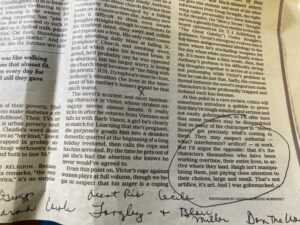Posts by Elizabeth Havey
While writing, are you worried about phrases like authenticity, loose ends?
If SO, ASK YOURSELF: WHERE SHOULD EACH OF MY CHARACTERS END UP?
Writing a novel is about communication. Outside of creating fascinating characters, a gripping plot, or filling pages with beautiful, engaging language, a novel should be clear in its purpose, its presentation and especially its ending.
In a recent review of Jennifer Haigh’s Mercy Street, author and critic Richard Russo not only wrote insightful comments about this excellent work of fiction, he also provided some creative insight for the rest of us.
Russo wrote: “At this point in a rave review, critics will sometimes introduce a quibble to prove that they’re tough-minded and serious and not easily gob-smacked.”
He then presents an authorial problem: do writers sometimes interfere with the lives of their characters, a kind of artifice at work? He writes: “But I’d argue the opposite: that it’s the characters themselves who have been working overtime their entire lives, to arrive where they land.”
His point becomes a fascinating way to praise a writer: stating that Haigh isn’t manipulating her characters, but rather paying close attention to their choices, bringing those choices to the page. When concluding his reading of the novel, and then his review, Russo writes that he was gob-smacked, because down to specific details, each of Haigh’s characters had changed during the novel, had revealed their true selves. Haigh had not left readers asking: why was that character even presented, what purpose did he or she have, or what was that character’s message?
FORMING A PLAN
After reading that final line of Russo’s review, I grabbed a pen, and in the margins of the piece, wrote down the names of all the characters in my WIP.
Had I given each of them the power to identify their needs, admit their mistakes? Had I clarified their positive actions and decisions? Was all of that on the page, or was I leaving too much to interpretation? By the end of the novel, had I made it clear where each of their lives stood?
Every character in your novel counts. Each has a voice contributing to the chorus of the story. At the end, where do you see each of them? How are they to live when the novel ends? It’s impossible to leave them hanging, because each character affects the overall story. Their part in the rise and fall of your story’s line and action has to have a satisfying ending.
In one of his workshops, Donald Maass addresses the issue of creating a character, but also never abandoning that character.
“Characters don’t arrive as blank slates. Indeed, in our back story worshiping literary era, there is hardly a character we meet who does not already carry a wound, a burden, or arrive in a state of paralysis. In some novels, recovery is not the end result, but instead the entire body and point of the story…more generally though, characters are people who are explained by their psychology.”
I agree, though I think within the creative process, characters often spring to life without regards to their psychology. It is something we begin to consider as they grow on the page, inhabit the list of character attributes Maass provided: values, dark fears, public face. And let me add: […]
Read MoreThis morning, it was just there, a memory, the rusting railway overpass, scrawled with the words, DALE LOVES SOPHIE TO DEATH. Symbolism, but also story, remembrance of story.
The family has a fight in the car on the way there. Then they spot the familiar landmark, a graffito on a bridge: “Dale Loves Sophie To Death.”
From that image’s haunting symbolism, I then remembered the author’s name, Robb Forman Dew, that the story appeared in the New Yorker Magazine during a time when the stylistic choice of using present tense was popular i.e. Anne Beattie. And after reading that story, I read more of Forman Dew’s work, recently discovering that she died in 2020. I admit the basic story line is vague in my memory—but the scrawled words on the railway bridge so permanent, the story narrator’s marriage, probably not. (Anyone wanting to weigh in?)
So why the memory, and is it because of the image, the unusual symbolism? I would answer yes.
When we write, do we sometimes find ourselves falling in love with an image, a symbol, while also forgetting the hard framework of story? We definitely have to have both, though there must be a way to combine the two, incorporate symbols while building memorable story. Plot is the groundwork, yet its other elements essential, necessary. Adding symbolism is an artistic choice, verbal jewelry that pulls the reader in, enhances plot lines, makes story elements more memorable. Literary symbolism can be one or two words, even phrases, paragraphs, that encompass, echo and remind the reader of essential story elements. And yes, symbolism can be overused. Like real jewelry, a little goes a long way.
And now, I have to mention…And as I sat there, brooding on the old unknown world, I thought of Gatsby’s wonder when he first picked out the green light at the end of Daisy’s dock. He had come a long way to this blue lawn and his dream must have seemed so close that he could hardly fail to grasp it…So we beat on…
First, The Purpose of Symbolism
As a writer, I admit I love symbolism. If handled carefully, not over done, it is powerful, filling a reader’s brain with an image that lingers, that connects aspects of the story without the writer having to wave a flag—hey reader, remember this, lean in, it’s important, and I’ll be coming back here, so pay attention.
I believe a symbol, reoccurring throughout a work, is a literary choice that actually lights up the reader’s brain, is no longer a word, but in the hands of a deft writer, like F. Scott Fitzgerald, recalls an entire scene: his green light, the sign on Dew’s bridge—each becoming more than it is.
Emma Donoghue, when writing her novel The Wonder, wanted her protagonist to realize that her people, the English, were partly responsible for the Irish Famine. “But I didn’t want that just to be presented as a political argument.” Thus Donoghue has her protagonist walking along a road built by the starving Irish, who often died along the way. “…everything green and pastoral—and then we watch as she begins realizing that the bumps of the grass under her feet are not clods of soil, but skulls.” (from the essay […]
Read MoreMy last post for WU (Where I Should Be, A Writer’s Sense of Place) dealt with the importance of PLACE in our work, while focusing on my growing up in Chicago—the houses, vegetation, traffic, people—because place influences much of who we are. No one can write a memoir without place becoming a major character. Think: Black Boy, All Creatures Great and Small, Born a Crime. These works rely on references to the author’s birth and living place, the experience of local mores, even the streets where he or she walked and lived.
But place also plays a powerful role in fiction, orienting readers and pulling them into story. Some authors are masters at this. And even though Joan Didion writes nonfiction, I’ll later examine her evocative work to get your creative place juices flowing.
ACTION!
Think of place as the establishing shot in a film, or the curtain rising to reveal a stage setting. Like these visual introductions, our written beginnings should gradually unfold, using the tools of dialogue and description to orient the reader to place as well as character.
All readers want a solid beginning. They want to be drawn in. But not all novels immediately establish place, preferring to allow us to be privy to the MC’s thoughts or a story problem that will steadily expand. That can work well, but if readers are not grounded in where this person is–certainly not latitude and longitude, but to a place that allows visualization–we might lose them to questioning or even impatience. Place, as well as the topics that are part of your storyline, can stimulate a reader’s excitement and attraction.
First, consider how to orient the reader, because as they begin reading your work, they will unconsciously pull from memory the images that will aid them in entering the world you are creating, the place where you are taking them.
Take, for example, the first lines from a chapter in my WIP:
Jude wrung out her mop, the floor of the sterile hallway now shining like glass from one end to the other, clean, smooth. But for how long? One of those nurses had just run through, and later there was sure to be some bed heading to a delivery room, another to the OR, blood dripping from a sheet, from a body, some woman screaming like she’s about to die.
Easy. We’re in a hospital. If you read on, the visuals open up, drawing the reader further into the story, underlining how place is important, the hospital acting as a character that moves the plot forward.
Place enhances our work, allowing the reader to bring memory, feelings, and past experiences (negative and positive) to the page. And notice, the word hospital did not appear in the above selection.
Place opens the reader’s eyes to the usual, but pulls the reader in more and more when events and characters living and moving within that place are not usual, are beyond normal, are the amazing creations of your imagination.
NOW: SOME BACKSTORY
I’m guessing that a story or novel you are working on, or one that has already been published, pulled some of its elements from your experience of place—which can be damn stimulating. I’m fortunate to have lived […]
Read More










